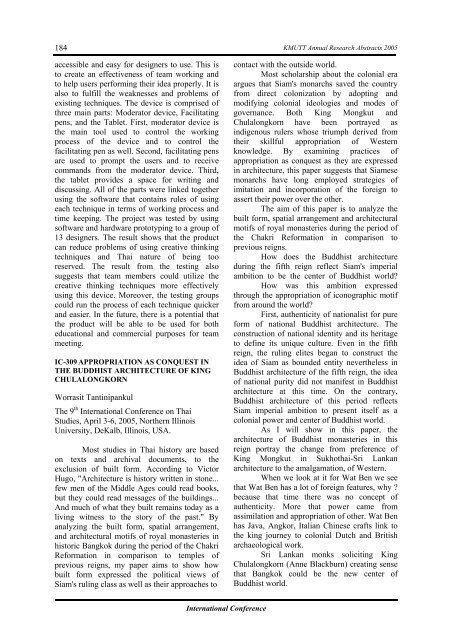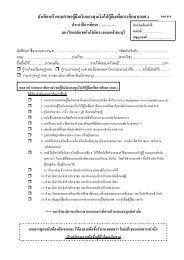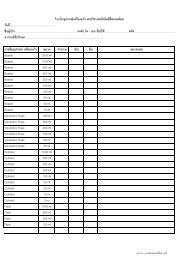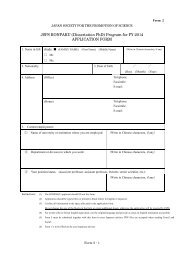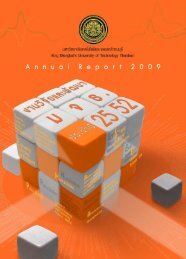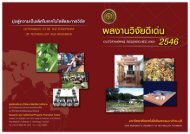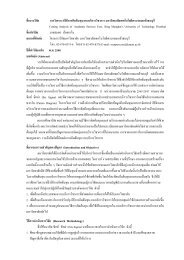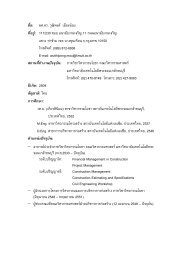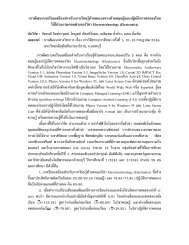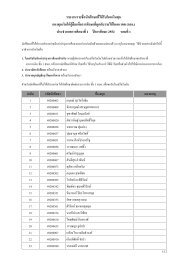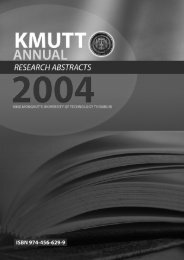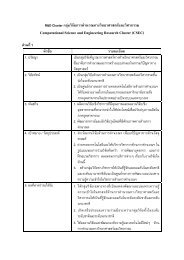Create successful ePaper yourself
Turn your PDF publications into a flip-book with our unique Google optimized e-Paper software.
184<br />
accessible and easy for designers to use. This is<br />
to create an effectiveness of team working and<br />
to help users performing their idea properly. It is<br />
also to fulfill the weaknesses and problems of<br />
existing techniques. The device is comprised of<br />
three main parts: Moderator device, Facilitating<br />
pens, and the Tablet. First, moderator device is<br />
the main tool used to control the working<br />
process of the device and to control the<br />
facilitating pen as well. Second, facilitating pens<br />
are used to prompt the users and to receive<br />
commands from the moderator device. Third,<br />
the tablet provides a space for writing and<br />
discussing. All of the parts were linked together<br />
using the software that contains rules of using<br />
each technique in terms of working process and<br />
time keeping. The project was tested by using<br />
software and hardware prototyping to a group of<br />
13 designers. The result shows that the product<br />
can reduce problems of using creative thinking<br />
techniques and Thai nature of being too<br />
reserved. The result from the testing also<br />
suggests that team members could utilize the<br />
creative thinking techniques more effectively<br />
using this device. Moreover, the testing groups<br />
could run the process of each technique quicker<br />
and easier. In the future, there is a potential that<br />
the product will be able to be used for both<br />
educational and commercial purposes for team<br />
meeting.<br />
IC-309 APPROPRIATION AS CONQUEST IN<br />
THE BUDDHIST ARCHITECTURE OF KING<br />
CHULALONGKORN<br />
Worrasit Tantinipankul<br />
The 9 th International Conference on Thai<br />
Studies, April 3-6, 2005, Northern Illinois<br />
University, DeKalb, Illinois, USA.<br />
Most studies in Thai history are based<br />
on texts and archival documents, to the<br />
exclusion of built form. According to Victor<br />
Hugo, "Architecture is history written in stone...<br />
few men of the Middle Ages could read books,<br />
but they could read messages of the buildings...<br />
And much of what they built remains today as a<br />
living witness to the story of the past." By<br />
analyzing the built form, spatial arrangement,<br />
and architectural motifs of royal monasteries in<br />
historic Bangkok during the period of the Chakri<br />
Reformation in comparison to temples of<br />
previous reigns, my paper aims to show how<br />
built form expressed the political views of<br />
Siam's ruling class as well as their approaches to<br />
KMUTT Annual Research Abstracts 2005<br />
contact with the outside world.<br />
Most scholarship about the colonial era<br />
argues that Siam's monarchs saved the country<br />
from direct colonization by adopting and<br />
modifying colonial ideologies and modes of<br />
governance. Both King Mongkut and<br />
Chulalongkorn have been portrayed as<br />
indigenous rulers whose triumph derived from<br />
their skillful appropriation of Western<br />
knowledge. By examining practices of<br />
appropriation as conquest as they are expressed<br />
in architecture, this paper suggests that Siamese<br />
monarchs have long employed strategies of<br />
imitation and incorporation of the foreign to<br />
assert their power over the other.<br />
The aim of this paper is to analyze the<br />
built form, spatial arrangement and architectural<br />
motifs of royal monasteries during the period of<br />
the Chakri Reformation in comparison to<br />
previous reigns.<br />
How does the Buddhist architecture<br />
during the fifth reign reflect Siam's imperial<br />
ambition to be the center of Buddhist world?<br />
How was this ambition expressed<br />
through the appropriation of iconographic motif<br />
from around the world?<br />
First, authenticity of nationalist for pure<br />
form of national Buddhist architecture. The<br />
construction of national identity and its heritage<br />
to define its unique culture. Even in the fifth<br />
reign, the ruling elites began to construct the<br />
idea of Siam as bounded entity nevertheless in<br />
Buddhist architecture of the fifth reign, the idea<br />
of national purity did not manifest in Buddhist<br />
architecture at this time. On the contrary,<br />
Buddhist architecture of this period reflects<br />
Siam imperial ambition to present itself as a<br />
colonial power and center of Buddhist world.<br />
As I will show in this paper, the<br />
architecture of Buddhist monasteries in this<br />
reign portray the change from preference of<br />
King Mongkut in Sukhothai-Sri Lankan<br />
architecture to the amalgamation, of Western.<br />
When we look at it for Wat Ben we see<br />
that Wat Ben has a lot of foreign features, why ?<br />
because that time there was no concept of<br />
authenticity. More that power came from<br />
assimilation and appropriation of other. Wat Ben<br />
has Java, Angkor, Italian Chinese crafts link to<br />
the king journey to colonial Dutch and British<br />
archaeological work.<br />
Sri Lankan monks soliciting King<br />
Chulalongkorn (Anne Blackburn) creating sense<br />
that Bangkok could be the new center of<br />
Buddhist world.<br />
International Conference


